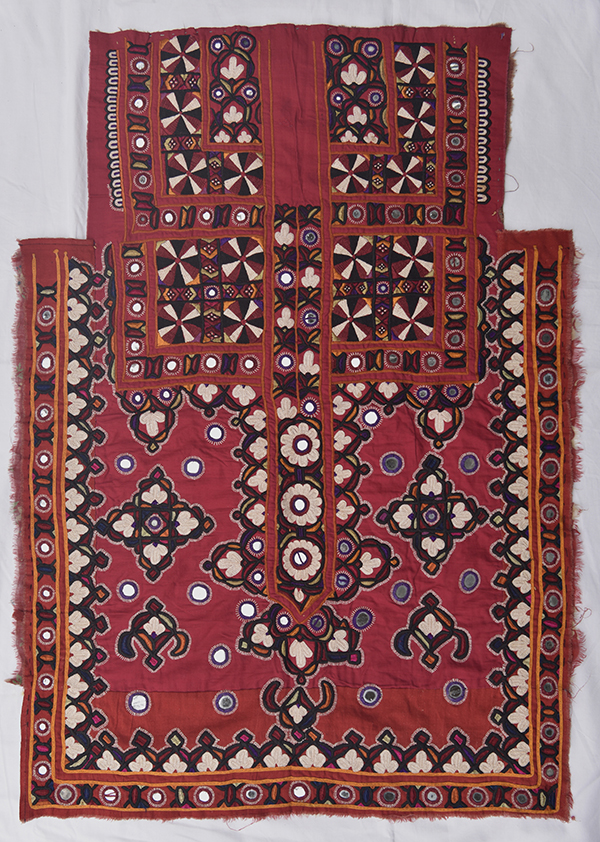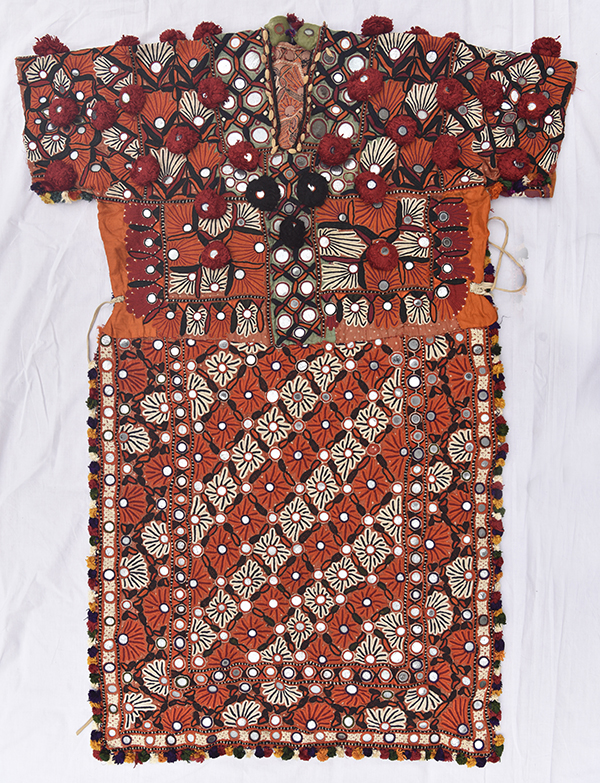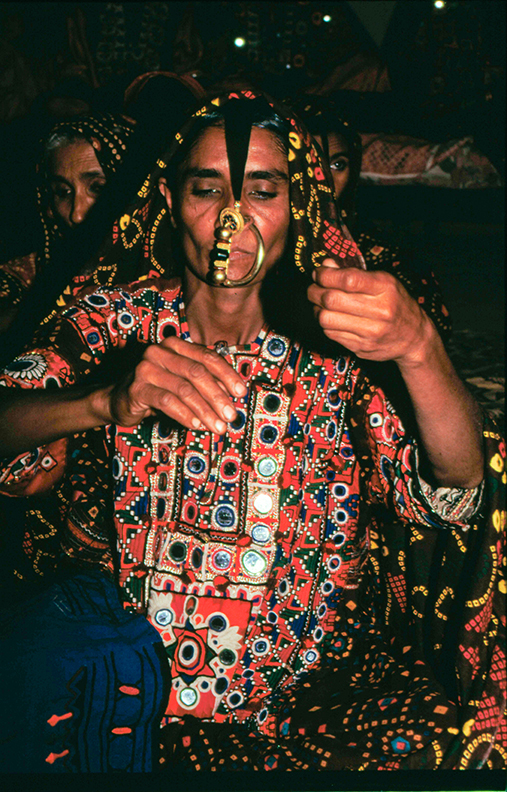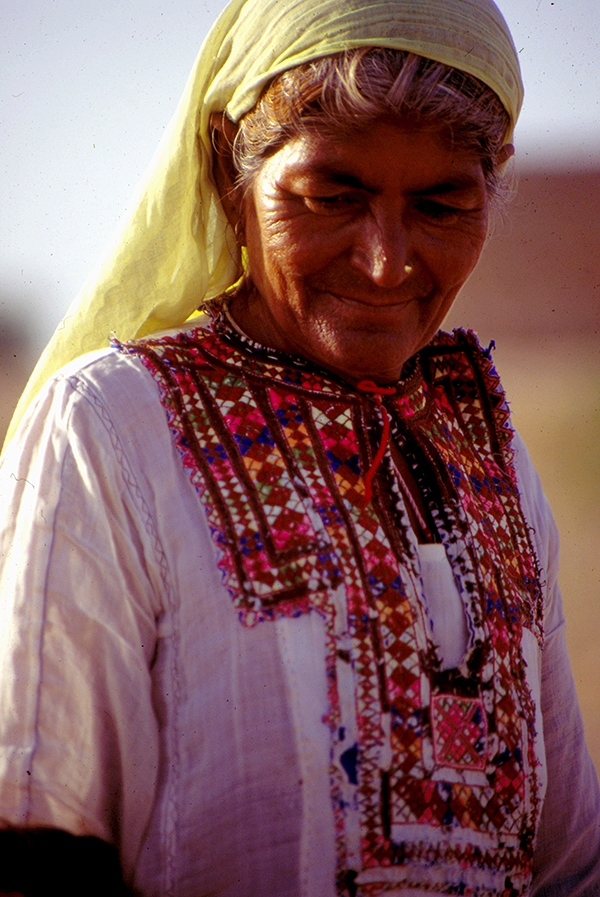Written by: Hurmat Majid
Posted on: November 10, 2020 | 
A Dress Pattern from Balochistan
Mohatta Palace in Karachi has reopened its doors to the public, eight months after lockdown was declared in March. For their first post-lockdown exhibition, the museum is showcasing ‘Gaj: Colours of the Rainbow’, featuring the chest patches that embellish women's long shirts in various cultures all over Pakistan.
The display features over 60 embroidered pieces from various areas of Pakistan, which have been borrowed from other public collections as well as private collections from all over the country. Embroidered chest patches are called ‘Gaj’ in Sindh, ‘Jeegh’ in Balochistan, ‘Iraghi’ in Hunza, Nagar and Ghizr valleys, and ‘Gulkari’ in Khyber Pakhtunkhawa.
The display has been curated by Nasreen Askari, Director and Co-Founder of The Mohatta Palace. Askari is also a celebrated author and expert on Pakistani textiles. She gained international recognition for her co-curation of the seminal exhibition, “Colours of the Indus: Costumes and Textiles of Pakistan” at the Victoria and Albert Museum in London in 1997. The catalogue of the exhibition has essentially become a standard referral point on traditional textiles of Pakistan.
In conversation with Youlin, Askari explained that the idea for the exhibit came while she was researching another traditional textile that was the ‘Ralli’, a traditional patchwork quilt made by women in Sindh. "However, there weren't enough pieces and variations that had been preserved. I did, quite by chance, stumble upon these beautiful motifs embroidered on these women's shirts and frocks."
Further elaborating her discovery and interest with the Gaj, Askari said: "What fascinated me was that these women had never been to art school or had any formal training, and yet they are experts on patterns and which colour will look best beside the other. Who taught them? No one. And that is how we discover that art comes from within, it is instinctive."
"These women spend months, sometimes even years on embroidering these patterns, and they do it because the chest patches are their identity, these designs do so much more than just beautify their clothes. Among locals, these designs are identification marks, one look at the pattern and they can tell which tribe the other belongs to," Askari elaborated.
Another fascinating discovery Askari made during her research on the Gaj was that the tradition of making and wearing them is not only present in the Sindhi tradition. Rather, there are similar embroidery patches in Balochistan, which merge and change as one travels to valleys in the Northern Areas and in parts of Khyber Pakhtunkhawa. While the style and stitches used in each of these traditions may vary, their purpose remains the same. They are not only used as identity and clan markers, but also as ways to embellish one’s clothes and show markers of femininity.
The exhibit itself has been set up in two large rooms and shows embroidered patterns from various parts of the country. The first room focuses solely on the Gaj and the next room carries designs from Balochistan, the Northern valleys and Khyber Pakhtunkhawa. Each piece comes with a description that specifies the date of its creation and the site of its procurement.
The Mohatta Palace was commissioned in 1927 by Shiv Rattan Mohatta, a successful Marwari entrepreneur. The palatial house was designed by Ahmed Hussein Agha who had come from Jaipur as chief surveyor for the Karachi Municipality. The palace remains Agha's most notable creation. Working in a Mughal revivalist style, Agha recreated the palace mirroring the Anglo-Mughal palaces of the Rajput princes. The building uses locally available yellow Gizri and pink Jodhpuri stone.
At independence in 1947, the Mohatta Palace was acquired by the newly established Government of Pakistan to house the Ministry of Foreign Affairs. Once the Ministry of Foreign Affairs was moved to Islamabad in 1964, the palace was offered to Mohtarma Fatima Jinnah as her formal residence. After Miss Jinnah's passing, it was formally purchased by the Government of Sindh, at the behest of Mohtarma Benazir Bhutto.
After the first phase of the museum's restoration was completed in 1999, it was opened to the public. Since then, it has housed over 25 major exhibitions, many of which include rare artifacts which have never been seen by the public.
The exhibition will continue until April 2021, and social distancing with all required SOPs will be enforced during that time. The wearing of masks on the premises is mandatory. The museum operates between Tuesday to Sunday from 11:00 AM to 6:00 PM.




You may also like: